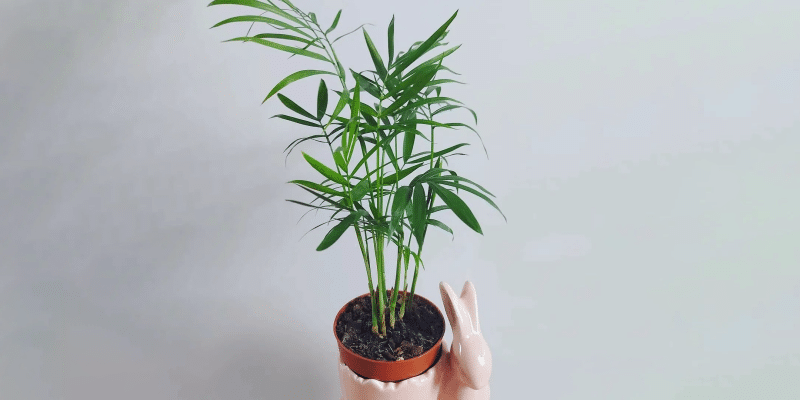Areca palm (the Butterfly palm) is a fast-growing palm that hails from Madagascar. It does well in a variety of conditions, both indoor and outside.
Easy care, air filtration, and fantastic as a privacy screen outside. What’s not to love?
(Not that we don’t love our neighbors!)
Let’s dive into Areca palm care, including ideal environmental conditions and how to propagate them.
We’ll also cover some of the most common tricky problems that do come up and how to easily take care of them.
Table of Contents
Areca Palm Care Guide
History, habitat, and characteristics
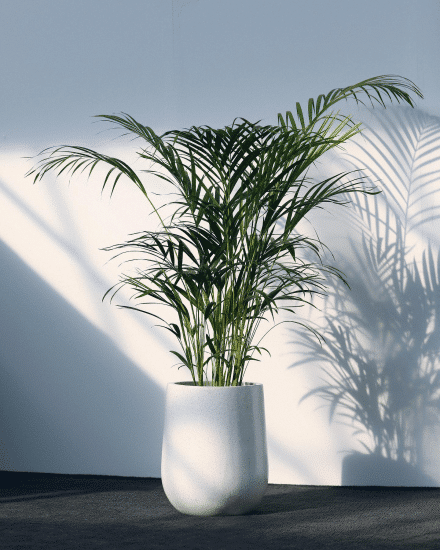
Areca Palm, or Dypsis lutescens (originally known as Chrysalidocarpus lutescens or Areca lutescens) is native to tropical forests in Madagascar. It’s also referred to as the golden feather palm, butterfly palm, yellow palm, bamboo palm, or golden cane palm.
Lutescens is Latin for “growing yellow,” referring to this plant’s stems and petioles (the stalk connecting a leaf to a stem), which range in color from yellow to orange, giving them a stunning visual gradient.
Areca palm pushes out many stems that form “clumps” from a single root, and long, narrow leafy green fronds that curve upward in a butterfly shape.
Outdoors, this palm touches the sky at over 30 feet tall, but indoors, they don’t reach higher than eight feet (a relief to those of us who live with ceilings). Leaves grow anywhere from 3 to 6 feet long with yellow midribs.
According to the University of Florida’s Institute of Food and Agricultural Sciences, these plants are an endangered species in Madagascar, so you’re doing the world a favor by growing Areca palm. Good for you!
(And the plant.)
Areca Palm Flowers
Areca palm blooms indoors with sprays of yellow flowers in clusters called panicles that reach up to 2 feet long. They’re not the main event, though, and neither is the small orange-yellowish fruit that comes afterward (it eventually matures to black). The leaves are the star of the show here!
Areca Palm Varieties
There are over 50 species of Areca palm (Dypsis lutescens). Here’s how to recognize some of the most popular.
- Areca catechu – Also nicknamed the Betel Nut palm, it has feathery, medium green fronds and produce fruit that turns from green to yellow as it matures. Its seeds are called Betel nuts.
- Areca ipot – Basically a mini Areca catechu that produces its own fruit with Betel nut-like seeds, this plant grows to six feet tall.
- Areca triandra – Also called the wild areca palm, a clustering palm with bright green leaves and flowers that smell distinctly lemony.
- Areca concinna – Often mistaken for Areca triandra, but much rarer in cultivation. Its stem is narrower and its flowers are less fragrant than those of A. triandra.
Light
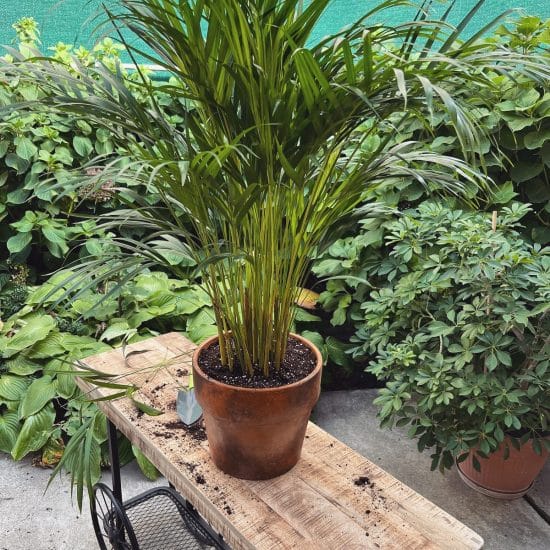
The Areca palm enjoys bright indirect sunlight, like the kind it receives in the tropical forests of its native habitat. It can tolerate some direct sunlight, however, making it a great plant to put where others might not thrive.
Too little light can cause your plant’s leaves to become yellow and leggy, and you’ll likely notice much slower growth.
On the other hand, too much light (especially direct sunlight) can cause leaves to yellow or brown and crisp, while also causing discoloration or sunburns. To help avoid this, keep an eye on leaf color: if they remain dark green and vibrant, then your plant is getting the right amount of light.
Water
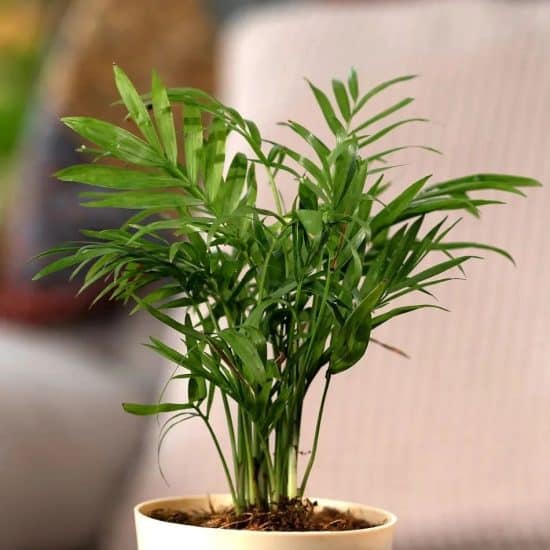
Proper watering is key to keeping your little green (and yellow!) friend thriving and healthy. The Areca palm prefers a regular schedule of drenching and drying out, just like it would get during rainfall in the tropical forests it hails from.
If the top 2-3 inches of soil feel dry to the touch, it’s time to give the plant a good watering. With this in mind, during spring and summer, which is the Areca palm’s active growth period, it will need to be watered around twice a week. In its inactive period during fall and winter, it should be watered less frequently, about once a week or two.
Of course, tap water may contain certain salts and chlorine, so if you notice yellow or browning on the leaves, try rainwater or filtered water instead.
Areca Palm watering tips:
- If the soil is dry and you notice leaf wilting and yellowing, you’re likely underwatering.
- If the soil is saturated and you notice yellow or brown leaflets that curl or droop, along with soft stems and mushy roots, you’re likely overwatering.
- Try to use filtered, distilled, or rainwater instead of tap water if possible, since salts and chlorine can build up in the soil over time and harm your plant.
Temperature and humidity
The ideal temperature for an Areca palm is between 65-75 degrees Fahrenheit—basically normal household comfort level. It can survive in slightly lower temps, but don’t let its environment dip below 50 degrees or things could get problematic.
Temperatures that are too high can cause leaves to yellow and develop brown tips, whereas temperatures that are too low can reduce or stop growth altogether. And we don’t want that for our palm!
Along those lines, your palm plant doesn’t like sudden cold or heat, so keep it away from drafty windows or radiators.
Humidity is just as important. If you give your Areca a spa day (or spa life) and keep the humidity between 40-60%, you’re golden. But if it drops too low, you might see signs of distress like yellow or browning, curling leaves with crunchy tips.
To boost the humidity:
- Build a mini jungle for your plant by clustering it with others so they can share moisture.
- Add a pebble tray to the mix. Fill up a tray with rocks or pebbles, add a splash of water, and put your Areca palm on top—the evaporation from the tray will raise the local humidity without giving your whole house a tropical makeover.
- Invest in a humidifier and keep it close by.
One thing to remember: Don’t mist the leaves of the plant, as this attracts pests and diseases, and doesn’t raise the humidity level for long.
Soil and planting
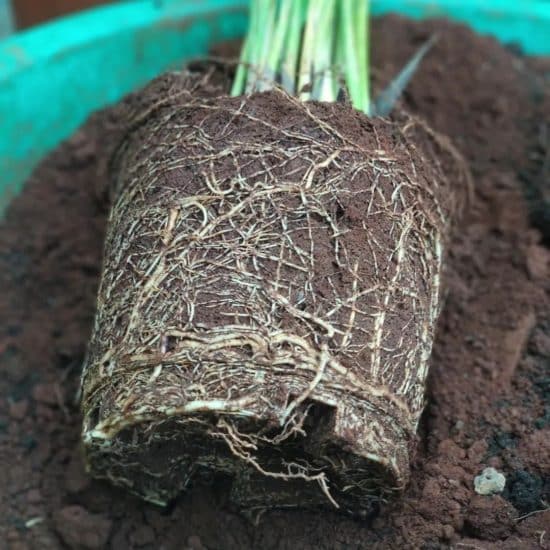
The main thing to remember about potting soil for your Areca palm is that it needs to be both moist and well-draining. It sounds oxymoronic, but it’s not hard to achieve in practice.
Our suggested mix:
- 1/3 high-quality potting mix
- 1/3 sphagnum moss or peat moss
- 1/3 perlite or pumice
You can also add a handful of horticultural charcoal, which removes impurities from your soil while improving aeration.
Repotting Areca palm
Dypsis lutescens grows slower than some other palms and actually likes being a bit rootbound, so you should only have to repot every two or three years (this also helps remove fertilizer salt deposits that can build up over time). Repot in spring when your plant is actively growing.
As always, when you choose another pot, pick one no more than two inches larger than the original, and make sure there are drainage holes (or at least one) at the bottom. (We don’t like root rot ’round these parts!)
When you’re ready to repot, gently place the root ball in its new home and tamp moist soil around it.
(Areca palm have brittle roots that can snap easily, so be careful here!)
Fertilizing Areca palm
Fertilize your palm with a 50% diluted balanced liquid houseplant fertilizer every month during the growing season (spring and summer). Give your plant a break during the winter months and don’t fertilize at all then, since it’ll be dormant and unable to take up the nutrients during this time anyway.
Now let’s learn how to make more little Areca palms!
Propagation guide
Propagating Areca palm plants with root division is a great way to expand your collection and make more for friends. In the springtime, the roots of the Areca palm are a bit easier to separate.
Propagating Areca palm by root division:
- Start by finding a healthy Areca palm with at least 3 distinct stems. Soak the soil around the plant’s roots to help loosen them the day before you begin your propagation project.
- Use your hands or a trowel to gently remove the Areca palm from its planter, taking care to free the root ball from the container.
- Gently wash away any dirt from the root ball to reveal the individual plants, taking note of any damaged or extra roots that need to be trimmed away.
- Carefully use a sharp, sterilized knife to divide the selected stems from the parent plant.
- Place the separated segments into new planters with the same soil mix as the mother plant, making sure to fill the new containers so there is only 1 – 2 inches of space at the top.
- Put the new planters in a place where they will get plenty of bright, indirect light and remember to keep their soil consistently moist, but not soggy. New leaves should appear in several weeks.
And voilà, you’ve officially propagated your Areca palm!
Common issues
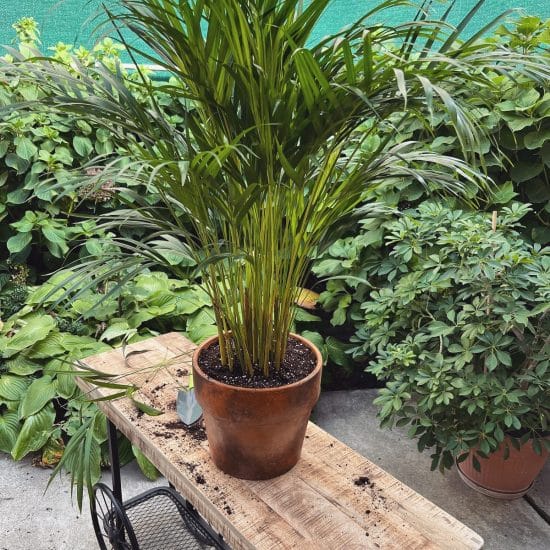
Areca palms are easy-care houseplants, but like any plant, they can still face some issues like drooping or brown fronds. Luckily for you, common issues equal common solutions!
Yellowing Leaves: Yellow leaves usually signify too much sun or water. Which is which? If your plant is right up against a window with direct sun, there’s your problem—move it a few feet away.
If your plant is getting only indirect light and you notice yellow drooping leaves with mushy stems, you’re overwatering. Make sure the pot has at least one drainage hole, and let the soil dry out more between waterings.
Brown Tips: Brown leaf tips or edges on leaves with dry soil means your plant either needs more or less water, or more or less sunlight. How to tell the difference? Location is key here.
If the problem starts with brown tips and moves down toward the stem, it means your plant isn’t getting enough sunlight or water. Be sure your palm is getting indirect sunlight and that you’re consistently giving it a healthy amount of water.
Conversely, if the browning begins at the bottom of the frond and starts moving upward, this points to overwatering or root rot. Repot it in fresh, dry soil and wait several days before you water again.
Diseases and pests
Areca palms don’t usually fall prey to many maladies, but the occasional disease or spider mite does come along (just kidding, there’s never just one spider mite!).
Let’s take a look at some of the most frequent foes to keep an eye out for, and how to combat them.
Root Rot
The dreaded root rot comes from overwatering. Mushy black and brown roots are a dead giveaway.
Solution: Cut off any affected roots and repot in fresh soil. Your pot should have at least one drainage hole. Soil should be moist without pooled water, and you should only water when the first two or three inches of soil is dry. If the issue keeps recurring, a larger pot may also help with root rot, since it’ll give the roots more space to spread out and breathe.
Fungus
Powdery mildew looks like a gray or white powdery coating on the upper surface of leaves. Spots with a yellow halo around them could be Helminthosporium leaf spot.
Solution: Always water your palm at its base and avoid wetting the leaves when you do it, since damp leaves are much more susceptible to fungus. The best way to battle these nuisances is to isolate your plant and treat the infection with an appropriate fungicide.
Bugs
Mealybugs look like small patches of fuzz or small white cottony masses. Signs of spider mites include webbing between or on the leaves.
Solution: To manage an infestation, isolate the plant to prevent pest spread. Gently rub down both sides of the frond with a damp cloth to dislodge any sneaky bugs, or spray down with a forceful stream of water. If this doesn’t work, consider using diluted neem oil. Re-apply every few weeks to knock out the eggs.
Conclusion
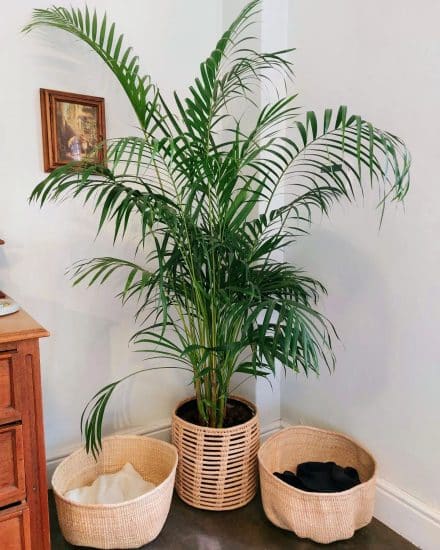
Lots of plant owners love indoor Areca palms because they look classic, are low maintenance, and purify the air—the best of three worlds!
And it’s true, these guys aren’t picky. Normal household temperatures and bright indirect light are basically all they need (and well-draining soil, of course). Propagate them by root division and you’ll have more for everyone.
Get in touch on Facebook or Twitter with questions . . . or pictures of where you put your gorgeous Areca palm!
FAQ
Are Areca palms high maintenance?
Not at all. These plants just need bright indirect light and soil that remains moist but not soggy, and they’ll brighten up a room without making you want to tear your hair out.
Is Areca palm a good indoor plant?
Honestly, I think they’re close to perfect indoor palms. They like normal household temps and do well being rootbound, so you don’t even have to repot them too often. Plus, they look classic and help purify the air, and who objects to that?
Can Areca palm take full sun?
Areca palm grow best in indirect sun, since full sun can burn their delicate fronds. If you only have a window that lets in direct light, move your palm a few feet back and use a transparent curtain to diffuse that hot sunlight a bit!

